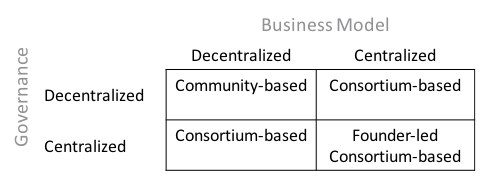Having reviewed the various business models, we can see that the control that each participant has will vary based on that model. By properly understanding the model and the interests of each party, we can create a decision process that makes sense to everyone.
So, while we understand that governance is about the process to reach a decision, should every single business, operational, and technical decision be managed and tracked by the governance process? Some would argue that only important topics should be covered by the governance process, but then what are the important topics? This is the role of a governance model: defining each decision domain and making sure everyone understands the level of ceremony (that is, the formalisms and official processes) to each category of decision. A bug fix to a smart contract may not require much attention, but an upgrade to the blockchain technology may require a heightened degree of focus. Agreeing upfront on how each of these categories should be handled will help current and future participants understand the expectations that will be placed on them.
Independent of the process complexity, another consideration that will need to be addressed will be the centralization versus decentralization of the decision making. Distributing the power of decision making may make the process seem fair, reduce the risk of undue control, and encourage free thinking, but in doing so, it may create delays in the achievement of a consensus.
While this makes sense in the context of a community-driven network, would it work with a founder-led network?
Probably not. If the founder is investing capital and resources, they may not want to share control over the network. Keep in mind that this is not an absolute rule. How critical the decision is will play a large role in the amount of control that is applied. Going back to our previous example of a bug fix on a smart contract, it could be expected that the decision as to when to deploy should be decentralized, but that the decision as to the next feature to implement should be centralized.
The following table shows the relationship between governance and business models, and (generally speaking) how the business model will drive the governance structure. Essentially, we can see that on both sides of the scale, we have the community-based network, which tends to be a completely decentralized business model, and thus can only survive in a decentralized governance:

An attempt at centralizing governance would probably compromise its very existence as the community members would either reject the control or push for the creation of a consortium. On the other end of the spectrum, we have the founder-led network, which by its very own nature tends to retain control in the founding organization. Consortium business models tend to be variable and depend very much on their own individual nature. A highly regulated industry may require an equivalent high degree of centralization to ensure that all parties adhere to the established standards. Then again, a consortium could achieve decentralized governance by imposing rules or adopting a consensus mechanism for decision making.
To conclude our examination of the role of governance in a business network, let's quickly look at the kinds of decisions that a business network will need to address:
- Membership life cycle: Decisions associated with the process of on-boarding and off-boarding participants to the network.
- Funding and fees: Decisions focused around how the network will be funded. This may cover areas such as centralized infrastructure, common services, staffing, and so on.
- Regulation: Most industries need to meet specific regulations that are often geographically bound. This category focuses on key decisions to ensure that these regulations are met and enforced.
- Education: Decisions on the level of training to provide to members and external organizations regarding the use of and integration into the network.
- Service life cycle: All decisions related to the IT components, covering aspects such as the deployment of new smart contracts all the way to system updates.
- Disputes: Because disputes are almost always unavoidable, these decisions deal with the resolution process.
In the next section, we will dive into each of these areas and explore some of their intricacies. However, it is worth noting that in every category of decision, there will be a balancing act between the following:
- Cost versus risk
- Competition versus cooperation
- Formalism versus agility
